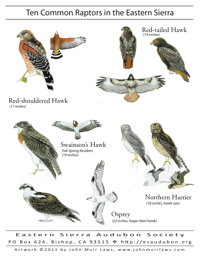Education
Eastern Sierra Audubon is involved in many educational projects, including our own Birds in the Classroom, and in partnership with other organizations, such as the Wild at Home program with Eastern Sierra Land Trust, Sierra Discovery Day, in partnership with Eastern Sierra Institute for Collaborative Education, and A Day with Jack Laws, in partnership with Laws Railroad Museum and Inyo Council for the Arts. We are always interested in helping to educate both children and adults about wildlife, birds and birding and the benefits of a healthy environment for all of us. Our latest effort in this regard is to offer scholarships for local high school seniors.
Announcing Eastern Sierra Audubon Scholarships

The Eastern Sierra Audubon Society is pleased to announce the availability of two $500 scholarships to graduating high school seniors in Inyo and Mono Counties. We intend to make these scholarships an annual award, encouraging local students to consider higher education and career choices that further the mission of Audubon.
The mission of the National Audubon Society is:
“To conserve and restore natural ecosystems, focusing on birds, other wildlife and their habitats, for the benefit of humanity and the earth’s biological diversity.”
Two scholarships, in the amount of $500 each, will be awarded by the Eastern Sierra Audubon Society to one Mono County and one Inyo County graduating senior whose work through higher education will promote these ideals either through science, education, advocacy, habitat conservation, art, journalism, literature, law, public policy, environmental justice or outdoor recreation.
Interested students must fill out a scholarship application form, including an essay in which they share an experience that inspired them and explain how it relates to the Audubon Mission Statement.
The deadline for applications is in April, with the exact date indicated on the form. We will announce recipients in a future online newsletter. We may also publish essays from awardees in future newsletters as well. Please share this information with any local high school students you know (and their parents)!
Check the most recent March-April Newsletter and the Scholarship Details page for updated information!
Birds in the Classroom
Our Birds in the Schools Program is currently offered to 3rd grade students at Pine Street School in Bishop. This program to acquaint students with the common birds of the Owens Valley consists of one classroom session and one field trip for each participating class. Prior to the field trips, Audubon volunteers will present slides and a video about birds and their adaptations and migration, and students will have an opportunity to discuss, share their own experiences, and ask questions that they may have. The class field trips to the Bishop City Park are scheduled during spring migration for maximum viewing of birds. Audubon provides child-size binoculars and training in their proper use for each student during the field trips. Students will also have the opportunity to learn about and use birding field guides. Volunteers are always welcome to help with the field trips.
Check the most recent March-April Newsletter for further information on volunteering!
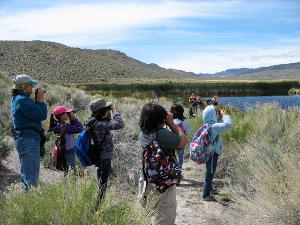
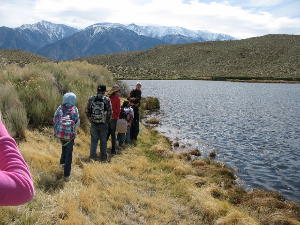
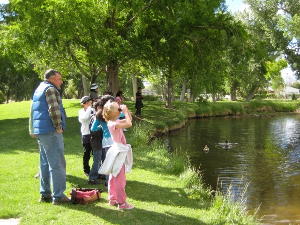

Wild at Home
In April 2010, we partnered with the Inyo & Mono Master Gardeners and Eastern Sierra Land Trust to present a workshop showing how native plants, garden features, and smart planning can make your yard a healthy habitat for birds, butterflies, and beneficial wildlife. Master Gardeners presented tips to help your yard and garden come alive with vibrant plants and interesting wildlife. Other topics included water-wise watering, safe and sustainable pest control, and specific information on gardening with native Eastern Sierra plants. Eastern Sierra Audubon then shared what birds, butterflies, and other wildlife you can expect to attract to your garden, now that you know how to create beautiful habitat.
Wild at Home - a Gardening Workshop
[Reprinted from the May-June 2011 Eastern Sierra Audubon Sierra Wave Newsletter]
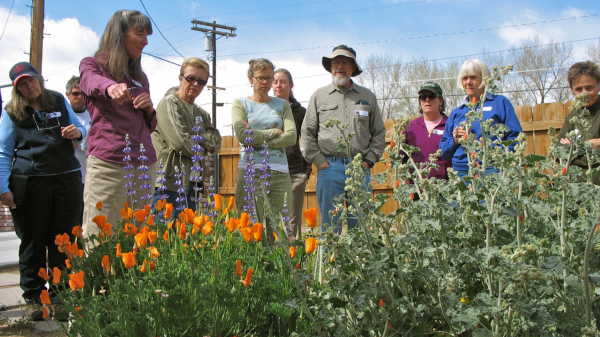
Karen Ferrell-Ingram speaking in the ESLT garden at the Wild at Home workshop
On Saturday, April 23, 2011, almost twenty interested gardeners gathered at the Eastern Sierra Land Trust garden to learn about how to garden for wildlife.Taking inspiration from a garden tour of the Eastern Sierra Land Trust native plant garden, each individual sat and listened to a marathon of information over the course of the morning.
Eastern Sierra Land Trust shared their mission of preserving vital lands in the Eastern Sierra, and how gardening for wildlife in your backyard connects your yard to the broader Eastern Sierra. A garden in your backyard helps to prevent urban areas from becoming a "dead zone" for wildlife.
Chalfant Big Trees Nursery presented a select list of native plants that benefit wildlife - as shelter or for food - that can be purchased from their nursery and grow well in the Eastern Sierra. For example, Mountain Mahogany (Cercocarpus ledifolius) is evergreen, provides good shelter and is also a food source for wildlife.
The Inyo & Mono Master Gardeners touched on a little bit of everything, from design elements to consider when planning your garden to how to keep the plants growing once you have them in the ground. Did you know that you need to think about having a diversity of levels? To have a wildlife friendly garden, you need to have low cover (small shrubs and flowers), medium cover (bushes), and high cover (trees).
Eastern Sierra Audubon spoke about what you will see once you have created a wildlife friendly garden.The key to seeing birds, lizards and butterflies is to slow down and take a moment to enjoy your garden and spy the wildlife.Create a space that is comfortable, easily accessed from the house, and one you would want to sit at for a moment. After all your hard work in the garden, award yourself with a quiet moment and sooner than later you are bound to see a few new visitors in your garden.
Lastly, Eastern Sierra Wildlife Care shared a few dos and don'ts to follow in your garden. Attracting wildlife comes with a responsibility to the animals. For example, don't place a bird feeder too close to a window, as a bird might fly into the window and hurt itself. Be sure to clean out your bird feeders regularly, especially nectar feeders.
We hope that you will begin to be inspired to transform your backyard into a wild home. Whether you add one flowering bush that attracts butterflies or you redesign your entire yard for birds, we imagine you will enjoy the change. Thank you to the following people who made this workshop possible: Pete Pumphrey, Roberta Lagomarsini, Karen Ferrell-Ingram, Hillary Behr, Cindy Kamler, Steve Blair and Carmen Kappos.
For more information on these topics, feel free to contact each organization. You can download Eastern Sierra Audubon's "Ten Common Backyard Birds" poster (shown at right), and a great Bird Feeder handout here: "Meet Your Bird Feeders": http://www.birdfeeding.org/best-backyard-bird-feeding-practices/bird-feeders/meet-your-bird-feeders.html
Click here if you'd like to download a better-quality version of the Ten Common Backyard Birds poster (1.62 Mb). Full size is also available (6.34 Mb)
Raptor Watch at Sierra Discovery Day

Ferruginous Hawk
Photo by Ron Overholtz
The first Sierra Discovery Day, put on by the Eastern Sierra Institute for Collaborative Education's (ESICE) with collaboration from Eastern Sierra Audubon, Eastern Sierra Land Trust, and others, was a fantastic event, with several locales and many great programs and activities for all ages. Go to the ESICE webpage on Sierra Discovery Day to learn more.
Sierra Discovery Day showcased the abundance of cultural and natural wonders in the Eastern Sierra. Using the theme of a treasure hunt, a day-long extravaganza of heritage events are planned for various locations in the northern Owens Valley.
Eastern Sierra Audubon partnered with ESICE and Eastern Sierra Wildlife Care to present a Raptor Watch program at Laws. Hawks are some of the year-round residents of the Owens Valley, and Laws is a great place to see them. We taught participants about these creatures and provided binoculars and/or spotting scopes and field ID tips for hawk watching. We also receive a visit from a special raptor guest from Eastern Sierra Wildlife Care, guaranteeing that everyone was able to see one beautiful raptor up close and personal!
Our poster of "Ten Common Raptors in the Eastern Sierra" with artwork by John Muir Laws will be a help in identifying birds of prey, and you may download it below.
We hope to participate in future Sierra Discovery Day Events!


